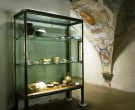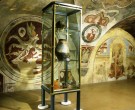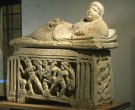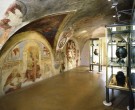> Home > What to visit > Museums

Museo Archeologico Ranuccio Bianchi Bandinelli Colle di Val d'Elsa
MUSEUMS
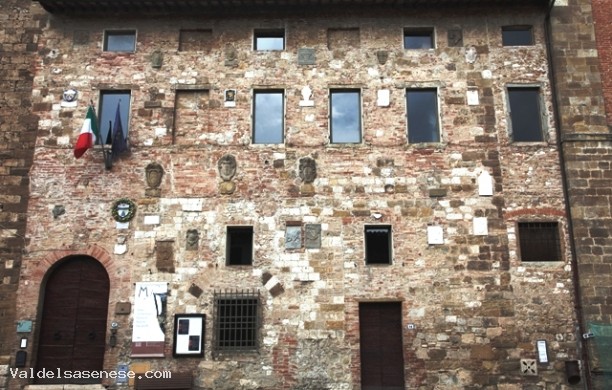
PHONE NUMBERS AND TIMES
Museo Archeologico Ranuccio Bianchi Bandinelli
Piazza Duomo, 42 Colle val d'Elsa
Telephone 0577 920490
Website: http://www.archeologiatoscana.it/presentazione.php?id=collevaldelsa
Business card (vCard)
ORARI DI APERTURA E VISITA:
Sunday 16-19
TICKETS: Free promo.
Established in order to preserve the Terrosi collection (purchased in 1972 by the Municipality) and the state-owned finds found in the area, it illustrates the history of the Valdesan area from the Eneolithic to the Middle Ages and is divided into three floors. The display criterion refers to the areas of origin of the exhibited materials. The ground floor is dedicated to medieval material; on the first and second floors thirteen rooms make up the museum, a prehistoric and Etruscan section. On the second floor are the headquarters and the restoration laboratory of the Colligiano archaeological group.
The museum is located in Palazzo Pretorio and entering from the main entrance, on the left, you enter the staircase leading to the upper floors and on the right to the access corridor on the ground floor where the ticket office is also located. On the opposite side of the ticket office, the route begins in four rooms, to be set up once again.
Content detail
GROUND FLOOR
Room 1
Plaster models made by the Colligiano artist Emilio Francioli, which reproduce the ancient castle with some monuments that no longer exist, such as the door to the Song. Leaning against the wall, the closing stone of the archaic Etruscan tomb no. 15 of the necropolis of Dometaia and a sporadic memorial stone of the Le Morticce locality.
Room 2
Series of sandstone capitals from the Pieve di S.Salvatore in Colle, destroyed to make way for the new cathedral in the 17th century. In the center of the room there is a splendid medieval well-shaped vault with four panels carved in bas-relief which describe scenes of country life. continuing you can visit some cells of the old prison remained intact and with graffiti written on the walls by the prisoners.
Rooms 3 and 4
Under construction with the majolica section.
FIRST FLOOR
Room 1
There are exhibited materials from the archaic Etruscan burial (VII-VI century BC) accidentally found in August 1984 during the renovation of a garden in Campiglia dei Fosci. The Tomb named Pierini from the name of the owner of the fund, is one of the most significant finds from the Etruscan era in the whole of Valdelsa for the particularity and integrity of its equipment.
Formed by two rectangular chambers divided by a central partition, the tomb had a series of depositions of incinerated in light dough. In the kit there is a multiple brown paste jar with Etruscan inscription, called by all the "salt shaker", perhaps from a workshop in northern Etruria and some Etruscan-Corinthian ointments.
Room 2
In the room are exhibits from the archaic period from the Monteriggioni necropolis and from recent excavations in Campassini. the large showcase (Monteriggioni, Terrosi collection), in the lower shelf contains a large ossuary (globular olla) in bronze from the Orientalising period (around the middle of the VII century BC), possibly from the Chiusina area; in the upper shelf it contains bucchero objects, among which a small vault with decorations embossed in a "cylinder". The small showcase contains a beautiful Villanovan biconical itinerary (8th century BC).
Room 3
The materials on display all come from the grave goods of the Calisna Sepu (Casone necropolis), formerly owned by Terrosi and purchased by the Municipality of Colle in 1972.
The tomb of the Calisna Sepu was found at the end of 1893 on the Casone estate, owned by the N.H.G. Earthy, practically intact. From the Hellenistic period (used from the end of the 4th to the beginning of the 1st century BC), it was the most significant discovery of this period in northern Etruria (450 finds).
The materials of the large chamber tomb, due to a series of vicissitudes, were partly dispersed, partly sold to the antiques dealer Maccianti at the Berlin museum and the largest part remained in Terrosi property.
The latter findings are exhibited at the Colle Museum, at the Guarnucci Museum in Volterra, at the Archaeological Museum of Florence.
Worth mentioning: the bronze cinerary vases; those in black Malacena paint; the four bronze mirrors with engraved scenes from Greek mythology; the three famous Volterrane kelebai painted in red figures, all three datable between the end of the VI and the beginning of the III sec. B.C.
The two cinerary urns are copies of originals found in Florence and Volterra, in their respective archaeological museums. Noteworthy is the copy of the great bisome cinerary urn, with a tile placed on the head of the deceased, to protect it from the dripping water in the grave.
Room 4
Material from the cleaning campaigns in 16 Etruscan tombs in the Dometaia area, carried out by the Colligiano Archaeological Group. Much of the Dometaia material is found, however, in the museum of Volterra.
Room 5
Tomb 17 of Dometaia: outside the showcase a large dough ziro, in the showcase the materials recovered during the emergency excavation of the tomb that came to light for the work of setting up an Enel cable. Of note the two large bleached vases (skyphoi) decorated with overpainting.
SECOND FLOOR
Room 6
In this room, in the central showcase, the Museum's greatest attraction is exhibited: the face of the so-called "Pig Girl", from the name of the place where the burial was found. It is a faithful plaster reproduction of a face of an archaic young Etruscan woman (6th century BC), performed by the specialists of the University of Pisa and by the archaeological superintendency who have adopted the most modern facial reconstruction techniques used in criminology.
Accompanying the deposition were two splendid gold "bauletto" earrings, one of which, to further increase the interest of the visitor, still attached to the bones of the skull due to the action of the limestone. Also in the room are some archaic Etruscan urns, two of which with inscriptions on the lid, which came to light during the cleaning of tomb no.10 in the Le Ville locality. One of these, very curious for the presence of only three feet, recalls the left-handed inscription of the "horseshoe" stele found in Canonica, and now dispersed.
Room 7
In three showcases the materials recovered in tomes 1, 8 and 10 of the Ville necropolis are displayed.
The tomes, archaic and heavily violated, have returned a large ovoid ziro with geometric decorations in red paint; two gray bucchero vases, one of which bears a row of knights "cylinder"; an Attic cup with black figures, decorated with a band painted with a floral motif representing a series of palmettes; bucchero objects and fragments of bronze horse harnesses; necklace beads and parts of a plastic decorated vase.
In particular from the small showcase of the tomb n.10 goldsmiths ("trunk" and "leech" earrings) and, truly noteworthy, the bone plates depicting fantastic animals, belonging to at least two cases.
Room 8
Also in two showcases the material from tombs 9 and 10 in Le Ville. Worth noting is a large impasto Ziro, various fragments of amber, an iron javelin spire.
Room 9
Here is one of the highlights of the museum: the prehistoric Eneolithic "grotticella" tomb (4th millennium BC) found in 1988 during road works in the Le Lellere area and recovered in extremis by the Archaeological Group. Unfortunately the second burial was almost completely destroyed by the works.
The tomb in question, although very damaged, revealed the remains of at least eight individuals deposited at various times.
The recovered set consists of eight arrowheads with wings and peduncles, six in jasper and two in flint and a fragment of ceramic belonging to a truncated cone-shaped vase.
The finding is of particular interest because it allowed to significantly backdate the burials of this type in the territory.
Room 10
The room has six showcases, all containing the remains of the grave set n.2 of the Ville necropolis. Used since the 5th century. B.C. as a typical large burial in use between the middle classes of the Valdelsa and its surroundings between the first half of the IV and the I century B.C.
Among the rich and fragmented material found, at least three chronological phases can be identified, but it would be too long to describe all the material found. To remember, however, fragments of a red-painted Attic crater with red-painted kilikes of the Sokra group of the mid-fourth century. to. C., various red-figure kelebai of the Volaterrae Group, two oinochoai of the Phantom Group, a fragmentary Genocilia plate, a service of so-called silver ceramic, cineraries and a large quantity of variously used pottery of local production.
Room 11
There are two showcases: showcase A contains the objects of tombs 6 and 7 of the Ville necropolis. Among the exhibits, there are some cinerary craters, pre-sealed ceramic, three black painted olle and an unusual object, perhaps imitating a mirror, in silver ceramic.
Showcase B contains the objects from tomb n.1, from the Quartaia necropolis. The finds are made up of achromes, brown and red varnished vases, a stone ax etc. A large amphora outside the window.
Room 12
Also in this room there are two showcases containing the materials of the Hellenistic tomb n. 2, excavated by the Superintendency near Casole d'Elsa in Orli.
The typology of the finds is roughly the same as the previous tombs described. In the same room, a small late Hellenistic chamber tomb found at Poggio di Caio, on the border with the town of Casole, was also rebuilt.
STAY NEARBY
LA VECCHIA CARTIERA
COLLE DI VAL D'ELSA
...RELAIS DELLA ROVERE
COLLE DI VAL D'ELSA
...VILLA BELVEDERE
COLLE DI VAL D'ELSA
...DINING & ENTERTAINMENT NEARBY
Teatro dei Varii
COLLE DI VAL D'ELSA
Posto quasi di fronte al Palazzo del Comune o dei Priori ha origini antichissime: prima os...Cinema Teatro Sant'Agostino
COLLE DI VAL D'ELSA
...Cinema Teatro Del Popolo
COLLE DI VAL D'ELSA
From: Notes on the theatrical tradition in Colle di Marcello Braccagni In: Miscellaneous...



